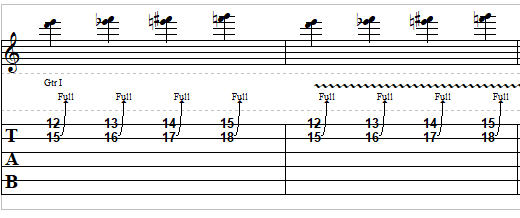
From The Video
Here’s a fun little technique that you can play around with. It’s called the Unison Bend. And this is what it sounds like. Playing two notes for this particular spike. We’re playing the twelfth fret, I’m using my first finger to play that twelfth fret, and I’m using my third finger to bend that fifteenth fret up a full step. I’m using my second finger to kind of support the bend. What happens is we bend that fifteenth fret up a full step so it sounds like the note on the seventeenth fret, which is the same note as the twelfth fret of the high E string.
So what we’re doing in effect is bending this note so both notes sound in unison. You strike both notes at the same time, and that’s this first part right here. Unison, of course, is two notes at the same pitch. So that’s why it’s called a unison bend. It’s a cool effect though because that bend, you hear that dissonance until you hit the top of the bend, so it’s kind of a cool effect. So what we’re going to do here, is we’re going to play in that Unison Bend I showed you and then we’re going to move everything up one fret and then we’re going to move it up again one fret and then we’re going to move it up again one fret. See it’s a cool effect.
Now for this second part, what we’re going to do is we’re going to do the same thing except we’re going to get that bend to the top. We’re going to add some vibrato to that bend.
So that’s just another way to expand upon the Unison Bend. Regular Unison bend, with vibrato. So it’s a cool effect if you’re wanting to throw a lick in there or are playing a solo and you want to have some pizazz. The Unison Bend might be just what you’re looking for. So I suggest you work that out. You’ll hear if you’re too short, it doesn’t sound right. You’ll want both notes, when you get that bend to the top you’ll want both notes to be playing at the same pitch. You don’t want to overbend either. It’s just going to sound like it’s out of tune.
So you kind of have to use your ears as a guide, and if you’re inexperienced with bends you might have a little trouble, but it’s also a great introduction to playing bends. Try not to let your fingers go to that G string, because you might end up cutting yourself a little bit, or when you pick your fingers up off the fretboard you’re going to end up accidentally strumming it.
But that right there is called the Unison Bend. And if you want to experiment with it elsewhere on the fretboard, basically, if you’re using the high E and B string there’s going to be a two fret difference between these two notes so the difference is the thirteenth and fourteenth note. So if you start on the twelfth fret, on the high E with your first finger for the B string, it’ll be on that third fret up, so the fifteenth. So if you’re down on the fifth fret, this again would be B string, eighth fret. So that is the Unison Bend, hopefully, you enjoyed.